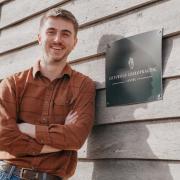To celebrate International Women’s Day, Gloucestershire Wildlife Trust reflects on the crucial roles played by women in the world of UK wildlife conservation
Terra, Gaia, Mother Nature. The names we’ve given to the seemingly divine forces that shape our natural world are all distinctly feminine.
Mother Nature is a force to be reckoned with, as are women in the conservation sector charting a course for a more diverse landscape and a future where wildlife can thrive.
The River Severn is the longest river in the UK and has been a common thread meandering through Alex Ball’s life and career.
‘I’ve had the pleasure of working in lots of different roles, from a conservation architect to a sustainable development manager and more and seeing the positive impacts across a number of organisations,’ says Alex, GWT’s funding manager.
‘I’d say one of my highlights was winning a National Lottery Heritage Award in 2009 live on BBC One; it was quite a moment! Or working with some brilliant women on Unlocking the Severn, and the biggest fish pass of its kind in England and Wales at the time – Diglis in Worcester.
‘During the pandemic, I reflected on how I wanted a role where I could be more focused on helping combat climate change and supporting nature. Now I’m working for GWT, this is something I can do, and I am really excited about that.’
But supporting nature requires bold and ambitious goals to strive towards, which is what attracted Emma Hutchins, GWT’s new director for nature’s recovery, to the role.
‘It’s good to go for the big, bold goals and to strive for that vision,’ says Emma. ‘We don’t want to not challenge ourselves! We’re all here because we’re passionate about what we do and want to achieve the most that we can for wildlife and nature.
‘Back when I started my first managerial position in land management, I was the only woman in a 30-person team – it’s brilliant to see that there are naturally more women in these roles today.’
Women in land-based careers have traditionally been under-represented, but a lot has changed since 1913, the year of the first International Women’s Day. While there is still a way to go, the number of women enrolling in agriculture-related higher education is rocketing, and in some places even overtaking the number of male applicants.

‘I’m really proud of the relationships I’ve developed with landowners and the trajectory of my career,’ says Emma.
‘The conservation sector is a competitive one, but my advice for anyone thinking of getting into the field would be to build up your experience. Degrees are not always a pre-requisite and, as long as you have drive, perseverance and are confident in your skills and abilities, then your hard work should pay off!

‘There are countless inspirational women and girls taking action around the world to address the biodiversity and climate crisis. What is critical is that whatever level women are working, there are sufficient resources available, that they’re given a platform to be equal players in decision making and that their understanding and knowledge is respected and valued.’
Unleashing the capability and knowledge of women in all areas of the sector represents an important opportunity to better craft effective solutions for the biodiversity and climate crises, for the benefit of all.
Representation matters for women, for conservation, and for our future, and empowering every man and woman to play a role in preserving our planet is our best hope.

COTSWOLD GREAT – SKYLARKS
In March the air is filled with a song that can rival even the nightingales – it’s the skylarks. Having been quieter over winter, when spring arrives male skylarks take to the skies for impressive crescendos that can last up to an hour.
Fluttering their wings to stay at their 50-200m vantage point, songs of linnets, curlews, redshanks and corn buntings are all thrown into the mix to attract a female.

When they’ve paired up, they go to the other extreme and fashion cup-shaped nests on the ground. These are particularly vulnerable to predators, or even dogs or walkers, which is one of the reasons for their decline, leading to them being classified as Red under the Birds of Conservation Concern.
They start singing before dawn, so their voice is the likely to be one of the first you’ll hear in the dawn chorus this spring.

DID YOU KNOW
The song of the skylark has been the source of inspiration or subject of many works of literature and music from Chaucer to Shelley, Vaughan Williams to jazz.

WILDLIFE-FRIENDLY GARDENING – UK COMPOST WEEK
March 13-19 is UK Compost Week, and composting is a great way to turn kitchen and garden waste into a nutritious soil improver while also creating a habitat for a world of mini beasts.
The secret of good home composting has a lot to do with the mix of materials used – a balanced combination of carbon-rich ‘browns’, like torn up cardboard, and high nitrogen ‘greens’, like grass clippings, can make the process particularly effective.
Another top tip is to keep pieces of waste small, whether you chop it up or put it through a shredder.
Ensuring the heap remains moist and putting it in a sunny spot will also help make the process a bit speedier.
Start your compost heap off with a layer of small twigs and woody plant stems to improve drainage and air circulation, followed by good layers of green and brown waste to get the process started. After that it’s a simple case of topping up the pile as things become available. After a few months the compost at the bottom will be dark and crumbly and just right for adding to the soil.

My Wild Life interview: Lydia Handy
This month we chat to Lydia Handy from Homegrown at Hampen about all things wildlife and farming, and how she hopes to rebuild connections between farmers and not only their local communities, but with each other.
‘Clive and I are the seventh generation of custodians of our 330-acre farm in the Cotswolds, and we’re endlessly fascinated with the network of nature.
Back in the day, our little farm supported as many as ten families, all working together and living off the produce. Nowadays farms have become isolated and detached, but we’re keen to rebuild that link between farmers and their local communities.

We’ve created a hub for people to come and explore what farming can be, how we farm with nature and where you can actually taste the difference of this partnership.
It’s also about giving people back that choice of being able to buy good quality food straight from the farms, and for us to produce local food for local people.
Our pop-up Saturday shop stocks not only our produce, but beef from a nearby farm, free-range eggs from another and so on. We also do lamb boxes and veggie boxes that can be picked up which have been really popular in our community.

I’m always at my happiest when I’m outside in nature and feel very strongly that we each have a part to play in caring for nature.
We’ve found that the recovery of nature is extraordinary when it’s given a chance – we’ve seen orchids flourishing in what had once been a conventional arable field and, though we’re a relatively small farm, we have two sets of breeding barn owls here!

The little changes we’ve made have made a huge difference. Letting some areas grow wild has given mice and voles places to scurry around, leaving nettles for butterflies and growing the hedgerows has made a huge difference in the number of different bird species, and thus raptors, we see.
Building resilience into our farming is really important, especially in the race against climate change. This is where heritage strains of wheat come in. They’re made up of about 100 different old varieties, so some like wet conditions while others like dry – these build in that resilience for whatever weather we may face.
We’re slightly hampered by there being no processing plants in the area to mill it into flour, but this is where those local connections shine. Because of the connections we’ve built, we know there are farmers nearby looking into setting up milling plants.
Another example of this is producing wool – we have a rare breed of sheep that produces this amazing wool, but there aren’t any facilities nearby for processing (yet!). This came as quite a surprise to us since The Cotswolds was built on the wool industry!
The wool will go hand in hand with the new ‘dye garden’ we’re setting up. We tend to be more familiar with the impact of our food choices, but less so of the clothes we wear – the dye garden will spark these conversations and encourage greener choices.
I feel that farmers have become so isolated and that we need to reconnect, and the younger generation agree.
It can be an uphill battle for a young farmer, so we try to foster a space where we can facilitate their ideas and encourage their enterprises. For example, last year a 21-year-old brought his sheep to graze on our herbal leys – we have more than we need so it was a win-win!

Young farmers bring a new dynamic to the table, along with new perspectives and being undaunted by what’s been before.
I also believe it’s important to let things go at nature’s pace. We’re in such a hurry all the time, but we don’t need to put so much stress on our animals, plants or ourselves. You have to be brave to step off that treadmill, but it feels good to let nature redress itself.
From herbal leys and soil health to beekeeping and bread-making, we’ve got a lot going on and I can see it going in all sorts of directions! It’s early days but it’s amazing how it’s taken off in such a short time. I really do hope that this is the future of farming.’
You can visit the Homegrown at Hampen shop on a Saturday, or if you’d like to get involved or have an enterprise idea they’d be delighted to chat. Find out more by visiting homegrownathampen.co.uk



























